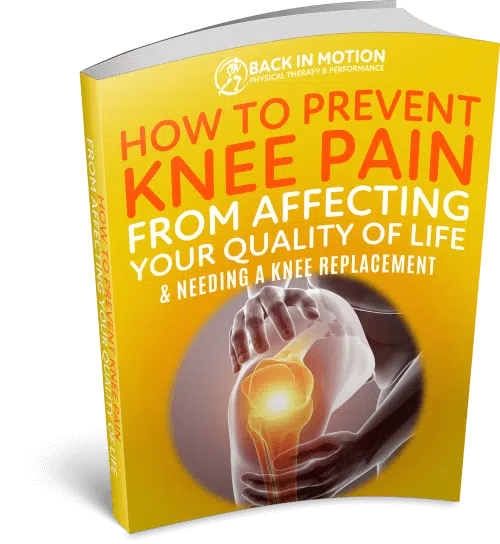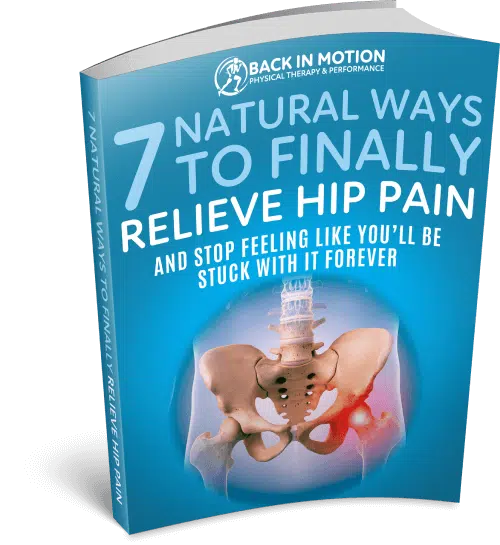10 Tips to Achieving Your Fitness and Health Goals
We all love the idea of getting fitter and healthier.
Some of us love the exciting challenge of pushing ourselves to new levels of fitness.
But a fitness plan can quickly go from fun to failure. Flaws in our plan can make reaching our health goals impossible and drain our optimism.
Our team at Back In Motion Physical Therapy & Performance knows how easy it is to make mistakes while creating a fitness plan on your own.
We also know what a successful plan involves.
We want to see you succeed in your fitness goals. A great health/fitness plan is sustainable and uplifting.
When you follow these 10 tips to achieving your health and fitness goals, you will enjoy the gains and avoid the pains of creating a fitness plan:
#1: Take a Full-Body Approach

“Lose belly fat!”
“Slim your thighs!”
We’ve all seen those ads focused on burning fat in one area of our bodies.
The truth is that you can’t target one area of your body to lose fat.
No matter how many crunches or squats you do, you’re not going to lose any fat in your belly or thighs unless you take a full-body approach to fat loss.
Instead of doing an excessive amount of exercise that targets one area of the body, do various exercises (such as multi-joint exercises) that target all of your major muscle groups.
A full body strengthening regimen, along with cardio, will help you avoid muscular imbalances and increase your overall health.
#2: Stay Consistent
One of the biggest challenges for most people when it comes to improving their fitness is staying consistent.
Consistency is crucial: if you are inconsistent with your workouts, achieving health goals is nearly impossible.
The best way to stay consistent is to schedule a plan every day to work out at a specific time.
We know: some days are so tiresome that working out is the last thing you’ll want to do.
But simply going for a walk or getting out the door for any type of exercise at your set time will help you form the habit of consistency.
You’ll find that once you get up and move at that set time, it will get easier and easier to stay consistent.
Most people start to notice increased energy levels throughout their day once they have a consistent routine going.
#3: Adjust Your Routine
Have you ever felt like your workout was too easy after three or four weeks of the same workout?
That’s because your body generally adapts to a routine in about three to four weeks.
To avoid the infamous “fitness plateau,” you should adjust your fitness routine every three or four weeks.
Some of the ways you can adjust your workout to enjoy continuous improvement include:
- Adding heavier weights, more sets, or more reps to your lifting routine every 7-10 days
- Increasing the duration or mileage of your aerobic training every 3-4 weeks
- Substituting some of your exercises with other types of exercises (for example, switching from the elliptical to swimming or from squats to kettlebell swings)
#4: Log It!
Logging your nutrition and activities in a journal or fitness app is one of the best ways to stay consistent and monitor your rate of success.
Look back in your log if you’re stuck in a rut to figure out what went wrong. Review your progress to see what went right. Having a log is an extremely useful and motivating tool for increasing your health and fitness.
#5: Vary Your Exercises
Who wants to do the same old exercise day in and day out, anyway?
Varying your aerobic and strength exercises will keep it fresh, aid in a healthy body composition, and help you avoid exercise related injuries.
For lifting days, you should devote some days to the following:
- Muscular Power: Heaviest weights you can handle for 6-8 reps
- Muscular Strength: Medium weights, 8-12 reps
- Muscular Endurance: Light weights, 15-20 reps
Building strength, power, and endurance will ensure muscular balance. Not only will this routine build lean muscle tone, but it will help you prevent injuries that are caused by muscular imbalances.

GET YOUR FREE REPORT
Free Special Report Reveals….11 Proven Diet & Fats Loss Secrets That No One Is Talking About
#6: Hydrate, Hydrate, Hydrate

Photo by Mariah Hewines on Unsplash
If you want to get toned and burn fat, you’ll have to work up a sweat.
You may have heard the 8×8 rule, which states that you should drink at least 8oz of water eight times per day. This is a good place to start, if you do not already drink at least this much water.
A more recent study from Mayo Clinic suggests that fluid intake (which includes water, food, and hydration beverages) should be at least 15.5 cups (3.7 liters) of water for men and 11.5 cups (2.7 liters) for women each day.
We all know that dehydration is dangerous and even life threatening if severe, but it can cause all sorts of problems such as decreased energy, issues sleeping, and slower metabolism even when the dehydration is mild.
Make sure you’re taking in both water and electrolytes. Electrolytes are especially important if you live in a hot, humid environment or are sweating a lot through training.
A few of the best natural sources of electrolytes include:
- Coconut Water
- Fruit smoothies
- Apricots
- Sports drinks (avoid ones with excess sugar & artificial ingredients)
- Watermelon
- Cow’s milk
Common signs of dehydration include thirst, dark urine, dizziness, lethargy, weakness, dry skin, and a dry mouth/tongue. Call your doctor if you are experiencing any of these symptoms or other symptoms that are of concern.
#7: Don’t Just Pay Attention to the Numbers
While weighing yourself regularly is a good idea to monitor your health, it is not so great for assessing changes in your body fat percentage.
If you’re not seeing the numbers on the scale go down but you feel like you’re getting healthier – don’t get discouraged.
You might just be losing fat and gaining more muscle…which is awesome!
A better way to evaluate your progress is to take monthly photos or use a tape measure.
#8: Allow Yourself to “Cheat”
Your friends want to catch up over some drinks and dessert.
“Sorry I can’t, I’m trying to get fitter…” you begin with a sad sigh.
In reality, enjoying the occasional treat is totally okay! Following a strict set of rules where you can’t enjoy dessert now and then is unmotivating and unsustainable.
Sure, you want to consume whole foods that are natural and nutritious as much as possible.
But you also want to have fun with your fitness journey.
Having a little “cheat treat” is not a big deal…after all, you’ve worked for it!
#9: Make it Fun!

Photo by bruce mars on Unsplash
If your fitness routine is lame, your TV or laptop will seem a lot more appealing than getting out the door for some exercise.
Treadmills and stationary cardio machines are nice for terrible weather, but most of us dread spending long periods of time on one type of cardio machine.
There are many solutions to turn a boring routine into a blast.
Here are a few of the best ways to make your workout more fun:
- Stuck inside? Switch machines every 15 minutes and bring some upbeat music
- Head to a park or new place
- Look up fitness groups in your area (or sport-specific clubs like cycling or running clubs)
- Don’t go alone! Asking a friend or family member to join you (even if you aren’t the same pace) will keep you accountable for showing up
- Visit a personal trainer. For many people, this is the easiest and quickest way to achieve fitness goals. This also leads us to our next tip…
#10: Try Personal or Small Group Training
The surest way to reach your goals is to work with a personal trainer or go to small group training.
A personal or small group trainer is considered a fitness expert. They stay up to date with the latest trends and can easily educate their clients on what works and what doesn’t.

The best personal or small group trainer is NSCA (National Strength and Conditioning Association) certified. This certification proves that your trainer has the proper education and experience to provide a high quality and safe training program.
Small group training should have no more than three people per group, while personal training is one-on-one. The key difference between personal and small group training is:
- Personal training: More expensive; however, you get one-on-one support throughout the entire session, and a fully personalized plan.
- Small group training: Less expensive, but you still receive plenty of one-on-one support from the trainer. While you won’t have quite as much time with the trainer as personal training, this is a wonderful option if you’re looking for affordability and many of the same benefits.
Unlike visiting the gym or a fitness club, a personal or small group trainer holds you accountable for showing up – so if you have trouble staying consistent, this is the perfect option for you.
Other benefits of a great personal and small group training program include:
- Professional support from a health and fitness expert
- A personalized plan that promotes continuous improvement
- Continuous monitoring to ensure you are doing exercises safely and correctly
- Health recommendations and nutrition advice
- A fun program that includes various exercises for full-body benefits
What Everyone Should Know About Personal & Small Group Training
Personal or small group training is the easiest and most effective way to conquer your health and fitness goals – if you choose the right one, that is.
Not all personal and small group training programs are the same. In fact, many still follow boring, old school weight loss methods such as logging hours each week on a stationary machine.
Also, many personal and small group trainers out there are not NSCA certified – meaning they are less educated on the safest and most successful techniques.
Luckily, our awarded personal and Small Group Training Fort Myers clinic have only NSCA certified trainers and a modern, fun program tailored to your specific goals.
Not only are our trainers NSCA certified, but our program is overseen by a Doctor of Physical Therapy, making it one of the safest programs out there.
At Back In Motion Physical Therapy & Performance, we will work together to build your custom plan for a lifetime of great health and fitness.









